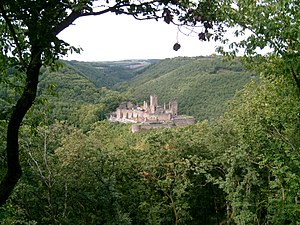Brandenbourg Castle
| Brandenbourg Castle | |
|---|---|
|
When it was in use, the Brandenbourg was at a strategically important point on a hill above two important traffic routes. |
|
| Alternative name (s): | Brandenbourg Castle |
| Creation time : | 10th century, first mentioned in 1244 |
| Castle type : | Hilltop castle |
| Conservation status: | ruin |
| Place: | Tandel -Brandenbourg |
| Geographical location | 49 ° 54 '46.4 " N , 6 ° 8' 15" E |
The Castle Brandenbourg (lux. Branebuerg , too) Castle Brandenbourg called, is the ruin of a Luxembourg hilltop castle in the same village in the municipality Tandel .
history
The origins of the castle are estimated to go back to the 10th century, but it was first mentioned in documents in 1244 in connection with its first known master, Gottfried. The castle was strategically located. It lay on the side of two traffic routes that were indispensable at the time: one from the Sauer to the Ardennes and the other from Burscheid to Vianden (two important bulwarks in the Luxembourg castle landscape).
The castle was not significantly modified until the 14th century when a fortified tower and a building below the hill were connected to the castle. The new building was even more imposing than the original keep and heralded a series of improvements in the centuries that followed. Subsequently, the east and south slopes of the castle were incorporated; two-story cellar vaults were carved into the rock here. In the north, which was Vorburg been a weak point in the fixture - - with the rest of the castle to a height brought and south were again in the curtain wall three half towers installed.
With the decline of chivalry, however, the old-fashioned fortifications lost their effectiveness. When Anton of Burgundy and his troops threatened the castle in 1413 , Brandenbourg surrendered to avoid its destruction despite the military strength. In view of the military obsolescence of the bulwark (compared to new types of weapons such as cannons), a large, round artillery tower was added to the curtain wall . Their kennel wall , provided with four more semicircular towers, was laid out and built, the entrance reinforced and the main moat widened.
Without ever being able to prove its military strength, the castle was abandoned in the 18th century. With the growth of the cities and the constant downsizing of territories by neighboring great powers (such as the Congress of Vienna ), the Grand Duchy of Luxembourg increasingly lost its former strength. The rural population was no longer interested in maintaining a fortress , which is why the Brandenbourg was left to decay.
On April 15, 1936, it was placed under monument protection. Today it is a popular hiking destination and is maintained by the municipality and the state of Luxembourg.
literature
- François Reinert: The castles and palaces of Luxembourg. Merckx, Brussels 2008, ISBN 978-90-74847-55-1 .

